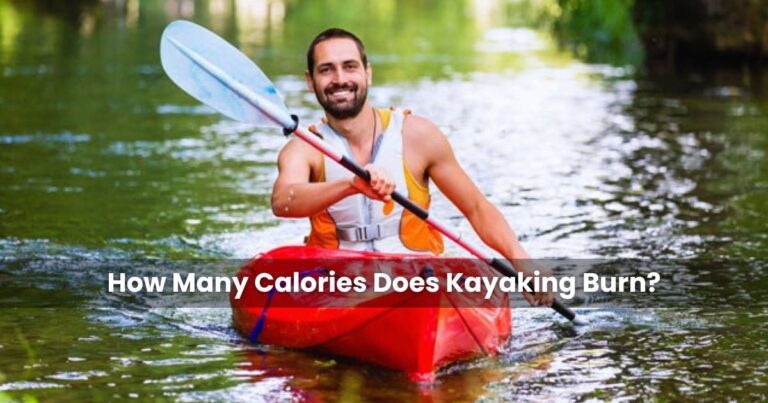Gliding across serene waters, the gentle splash of your paddle cutting through the surface kayaking isn’t just a peaceful escape, it’s also a powerful calorie-burning workout. But exactly how many calories does kayaking burn? Whether you’re looking to shed a few pounds or simply curious about the fitness benefits of this popular water sport, understanding the calorie-burning potential of kayaking can help you paddle your way to better health.
Kayaking is a versatile activity that engages multiple muscle groups and can provide an excellent cardiovascular workout. The number of calories burned while kayaking varies widely depending on factors such as your body weight, paddling intensity, and the conditions of the water. On average, a 150-pound person can burn between 300 to 500 calories per hour during recreational kayaking. However, this number can increase significantly with more intense paddling or challenging water conditions.
In this article, we’ll dive deep into the world of kayaking and calorie burn. We’ll explore the factors that influence energy expenditure, compare kayaking to other popular exercises, and provide tips on how to maximize your calorie burn on the water. Whether you’re a seasoned kayaker or considering dipping your paddle for the first time, you’ll discover how this enjoyable outdoor activity can be a key part of your fitness journey.
Table of Contents
How Many Calories Do You Burn While Kayaking?
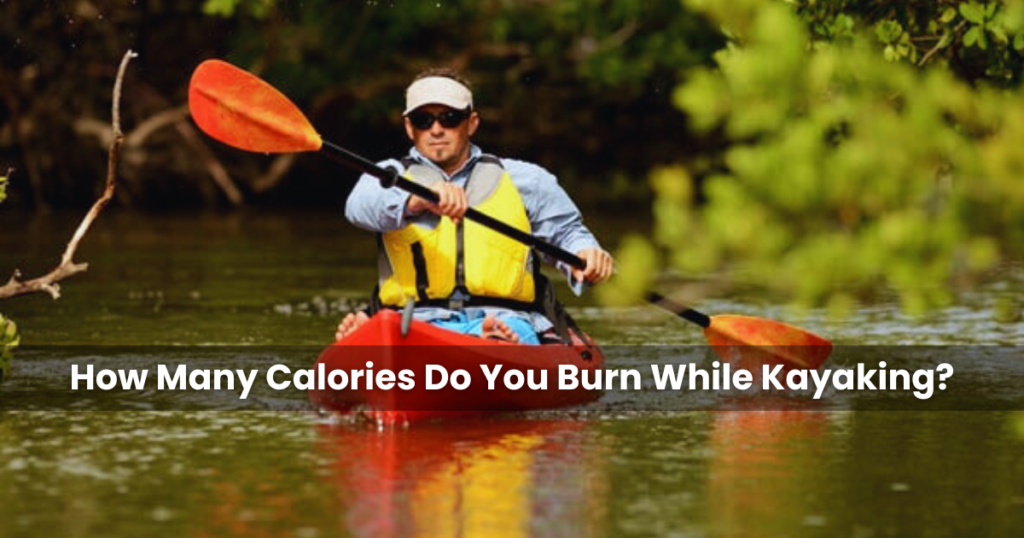
Kayaking is an excellent full-body workout that can burn a significant number of calories. The exact number of calories burned while kayaking depends on several factors, but on average, a 150-pound person can expect to burn between 300 to 500 calories per hour during recreational kayaking.
However, this number can vary widely based on factors such as your body weight, paddling intensity, and water conditions. For instance, a person weighing 200 pounds might burn closer to 400-600 calories in the same time frame. Intensity plays a crucial role – leisurely paddling on a calm lake will burn fewer calories than battling against currents or waves in open water.
To put this into perspective, kayaking can be as effective for calorie burning as cycling or brisk walking. In fact, vigorous kayaking can burn even more calories, potentially up to 700 calories per hour for a 150-pound person. This makes it an excellent option for those looking to combine outdoor recreation with an effective workout.
It’s worth noting that kayaking engages multiple muscle groups simultaneously. Your arms, shoulders, and back work to propel the paddle, while your core muscles stabilize your body, and your legs provide additional power and control. This full-body engagement contributes to the high calorie burn and makes kayaking an efficient form of exercise.
Factors Affecting Calorie Burn While Kayaking
When it comes to burning calories through kayaking, several key factors come into play. Understanding these elements can help you maximize your workout and achieve your fitness goals on the water.
Body Weight and Composition: play a crucial role in determining calorie burn. Generally, individuals with higher body weight tend to burn more calories during physical activities, including kayaking. This is because it requires more energy to move a larger mass through the water. However, body composition also matters – those with more muscle mass may burn calories more efficiently due to higher metabolic rates.
Intensity of Paddling: A leisurely paddle on a calm lake will burn fewer calories compared to an intense workout with powerful, frequent strokes. Your kayak stroke efficiency also factors in here – experienced kayakers who have honed their technique may actually burn fewer calories for the same distance compared to beginners, as their movements are more streamlined and less energy is wasted.
Duration of the Activity: The longer you kayak, the more calories you’ll burn. A short 30-minute paddle will naturally burn fewer calories than a 2-hour expedition. However, it’s important to note that intensity and duration often have an inverse relationship – it’s challenging to maintain very high intensity for extended periods.
Water Conditions: can significantly affect your calorie burn. Paddling in calm waters requires less effort compared to navigating choppy seas or fighting against strong currents. Rough water conditions force you to engage more muscle groups and expend more energy to maintain control and direction of your kayak.
Type of Kayaking: Recreational kayaking on a placid lake typically burns fewer calories than sea kayaking or whitewater kayaking. Whitewater kayaking intensity is particularly high, as it requires rapid decision-making, constant maneuvering, and often involves short bursts of intense paddling. Sea kayaking, while generally less intense than whitewater, often involves longer durations and can lead to significant calorie burn over time.
Average Calorie Burn Rates for Kayaking
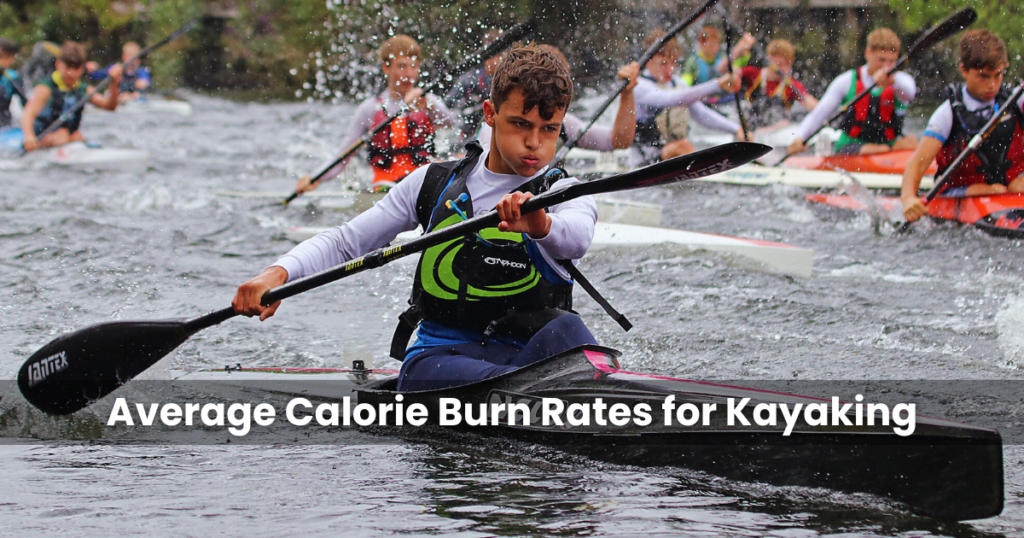
Kayaking is not just a serene way to explore waterways; it’s also an excellent full-body workout that can torch calories effectively. Let’s dive into the specifics of how many calories kayaking burns and how it stacks up against other popular activities.
On average, a person can expect to burn between 300 to 500 calories per hour while kayaking. However, this number can vary significantly based on factors such as body weight, intensity of paddling, and water conditions. A heavier person or someone paddling vigorously in choppy waters will burn more calories than a lighter individual leisurely floating down a calm river.
To put this into perspective, let’s compare kayaking to some other common physical activities:
| Activity | Calories Burned per Hour (155 lb person) |
| Kayaking | 300-500 |
| Swimming (moderate) | 400-500 |
| Cycling (12-14 mph) | 560-650 |
| Jogging (5 mph) | 590-670 |
| Walking (3.5 mph) | 280-320 |
As you can see, kayaking holds its own against other popular forms of exercise. It burns a comparable amount of calories to swimming, which is often touted as one of the best full-body workouts. The calories burned kayaking in 1 hour can easily match or exceed those burned during a brisk walk or a moderate jog.
When comparing kayaking vs. swimming calorie burn, it’s worth noting that while swimming might edge out kayaking slightly in terms of calories burned, kayaking offers unique benefits such as upper body strengthening and core engagement that swimming may not provide to the same degree.
The key to maximizing your calorie burn while kayaking is to maintain a steady, challenging pace and incorporate intervals of more intense paddling. This not only increases the calories burned but also improves your overall cardiovascular fitness and paddling technique.
Calculating Your Personal Calorie Burn
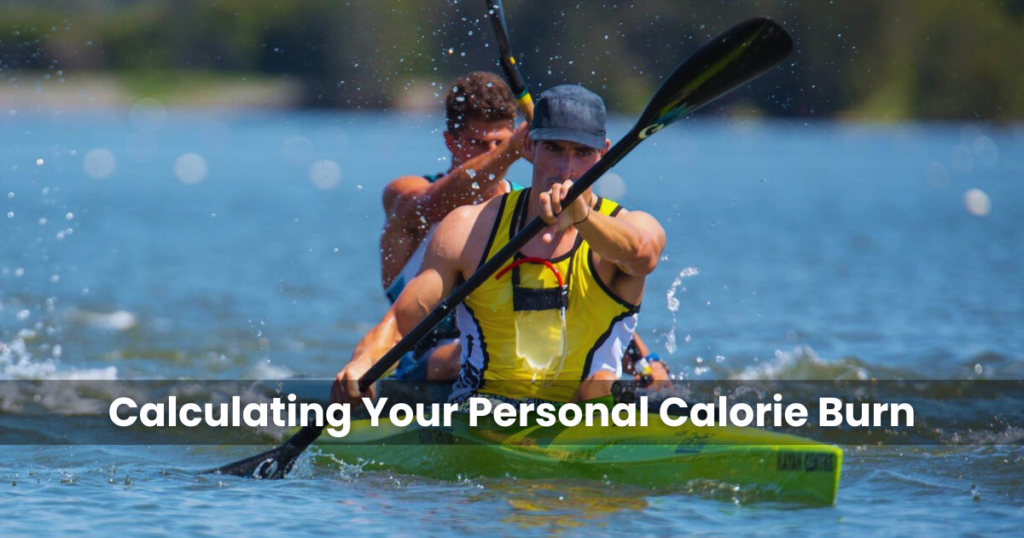
To truly understand the calorie-burning potential of kayaking, it’s essential to calculate your personalized energy expenditure. While general estimates can be helpful, your unique physiology and kayaking style play crucial roles in determining the exact number of calories you’ll burn on the water.
One of the most effective ways to estimate your calorie burn is by using a kayak calorie calculator. These online tools take into account various factors such as your weight, age, gender, and the intensity of your paddling. Simply input your details and the duration of your kayaking session to get a reasonably accurate estimate of your calorie burn.
For those who prefer a more hands-on approach, you can use the following formula to calculate your approximate calorie burn:
Calories Burned = (MET x Weight in kg x Time in hours)
MET, or Metabolic Equivalent of Task, is a measure of the energy cost of physical activities. For kayaking, the MET values typically range from 3.0 for light paddling to 7.0 for vigorous kayaking.
Let’s look at some example calculations to illustrate how this works:
Casual Paddling: A 70 kg (154 lb) person kayaking leisurely for 1 hour
- Calories Burned = 3.0 (MET) x 70 kg x 1 hour = 210 calories
Moderate Intensity: An 85 kg (187 lb) person kayaking at a steady pace for 2 hours
- Calories Burned = 5.0 (MET) x 85 kg x 2 hours = 850 calories
Vigorous Paddling: A 60 kg (132 lb) person engaging in intense kayaking for 1.5 hours
- Calories Burned = 7.0 (MET) x 60 kg x 1.5 hours = 630 calories
These calculations provide estimates. Your actual calorie burn may vary based on factors such as water conditions, wind resistance, and your paddling efficiency. To get the most accurate results, consider using a fitness tracker or heart rate monitor specifically designed for water sports.
Kayaking for Weight Loss: Real-World Success Stories
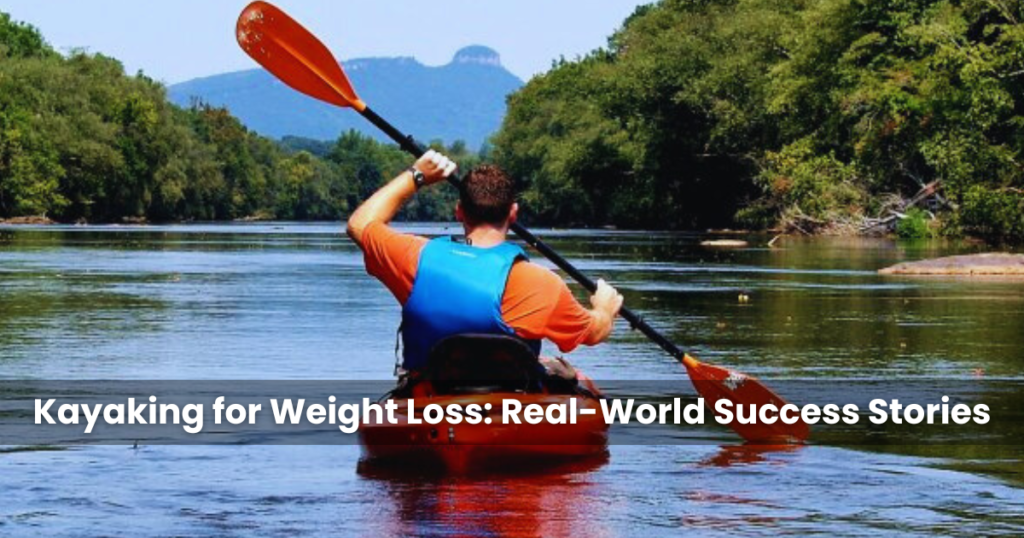
Embarking on a kayaking journey for weight loss can be an exhilarating and rewarding experience. Countless individuals have discovered the transformative power of this water sport, not only for shedding pounds but also for improving overall health and well-being. Let’s dive into some inspiring real-world success stories and glean valuable insights from those who have successfully paddled their way to a healthier lifestyle.
Sarah’s Triumph: Sarah, a 35-year-old office worker, found herself 50 pounds overweight and struggling with low energy levels. After taking up kayaking three times a week, she lost 30 pounds in just six months. “Kayaking became my escape from stress and my ticket to a slimmer, more confident me,” Sarah shares. Her success wasn’t just about the calories burned; it was the consistency and enjoyment that made all the difference.
Mark’s Transformation: At 45, Mark decided to combat his sedentary lifestyle by kayaking. Within a year, he shed an impressive 40 pounds and significantly improved his cardiovascular health. “I never thought exercise could be this fun. Kayaking doesn’t feel like a workout; it’s an adventure every time,” Mark enthuses.
These success stories highlight the kayak weight loss potential that many have experienced. But what tips do these successful kayakers have for others looking to follow in their wake?
- Start slow and build up: Both Sarah and Mark emphasize the importance of gradually increasing your kayaking duration and intensity.
- Mix it up: Vary your kayaking routes and techniques to keep things interesting and challenge different muscle groups.
- Combine with a balanced diet: While kayaking burns calories, pairing it with healthy eating habits amplifies weight loss results.
- Set realistic goals: Celebrate small victories and focus on consistency rather than rapid weight loss.
- Join a kayaking community: Many successful kayakers attribute their motivation to the support and camaraderie of fellow enthusiasts.
These kayaking for weight loss success stories serve as powerful testimonials to the sport’s effectiveness. They demonstrate that with dedication, proper technique, and a positive attitude, kayaking can be a game-changer in one’s weight loss journey. As you embark on your own kayaking adventure, remember that each stroke brings you closer to your health and fitness goals.
Maximizing Calorie Burn While Kayaking

To truly harness the calorie-burning potential of kayaking, it’s essential to approach your paddling sessions strategically. By implementing a few key techniques, you can transform your leisurely paddle into a high-powered workout that torches calories and builds endurance.
Increasing paddling intensity is the first step towards maximizing your calorie burn. Instead of maintaining a steady, comfortable pace, challenge yourself to paddle with more vigor. Engage your core muscles, power through each stroke, and maintain proper form to increase the overall energy expenditure. This not only burns more calories but also strengthens your upper body and core muscles.
For those looking to take their kayaking workouts to the next level, incorporating interval training can be a game-changer. HIIT kayaking (High-Intensity Interval Training) involves alternating between periods of intense paddling and recovery. For example, paddle at maximum effort for 30 seconds, followed by 60 seconds of moderate-paced recovery. Repeat this cycle for 15-20 minutes to significantly boost your calorie burn and improve cardiovascular fitness.
Another effective strategy is extending the duration of your kayaking sessions. While a 30-minute paddle is better than no exercise at all, aim to gradually increase your time on the water. As you build kayaking endurance, you’ll be able to sustain longer sessions, ultimately burning more calories and improving your overall fitness level. Start by adding 5-10 minutes to your usual routine and progressively work your way up to longer adventures on the water.
Kayaking vs. Other Water Sports: A Calorie Burn Comparison
When it comes to water-based workouts, kayaking stands out as an excellent full-body exercise. But how does it stack up against other popular aquatic activities? Let’s dive into a calorie burn comparison between kayaking and its water sport counterparts.
Swimming: Often considered the king of water workouts, typically burns more calories than kayaking. A vigorous freestyle swim can torch up to 700 calories per hour for an average-sized adult. However, kayaking isn’t far behind, burning around 400-500 calories in the same timeframe, depending on intensity and body weight.
Stand-up paddleboarding (SUP): Offers a unique balance challenge and engages core muscles intensely. It burns approximately 300-450 calories per hour, slightly less than kayaking but more than leisurely swimming. The kayaking vs. canoeing calorie burn comparison is interesting – both activities are quite similar, with canoeing burning about 200-300 calories per hour, while kayaking edges ahead at 300-400 calories.
Each water sport has its pros and cons for fitness:
- Kayaking provides an excellent upper body and core workout, is low-impact, and allows for exploration of various water bodies.
- Swimming offers a full-body, zero-impact workout and is excellent for cardiovascular health.
- SUP challenges balance and core strength but may be more difficult for beginners.
- Canoeing is similar to kayaking but generally burns fewer calories due to a more relaxed pace.
In this water sports calorie burn comparison, kayaking emerges as a well-rounded option. It combines the upper body workout of canoeing, the exploration possibilities of SUP, and approaches the calorie burn of swimming, making it an excellent choice for fitness enthusiasts looking to make a splash in their workout routine.
The Full-Body Workout: Muscles Engaged During Kayaking
Kayaking isn’t just a leisurely paddle on calm waters; it’s a comprehensive full-body workout that engages multiple muscle groups simultaneously. As you glide through the water, your body is working harder than you might realize, contributing significantly to the overall calorie burn.
Let’s break down the primary muscle groups worked during kayaking:
Upper Body: Your arms, shoulders, and back do the heavy lifting. Each paddle stroke engages your biceps, triceps, deltoids, and latissimus dorsi muscles. The rotator cuff also gets a good workout, stabilizing your shoulder joint throughout the motion.
Core: Your abdominal muscles and obliques are constantly engaged to maintain balance and transfer power from your upper body to your lower body. This core stability is crucial for efficient paddling and helps prevent lower back strain.
Lower Body: While not as obvious, your legs play a vital role. They provide the foundation for your paddling, pressing against the foot pegs to generate power. Your quadriceps, hamstrings, and calf muscles all contribute to this effort.
Back: Your erector spinae muscles running along your spine work to keep your posture upright, while your rhomboids assist in the pulling motion of each stroke.
This comprehensive muscular engagement is what makes kayaking such an effective calorie-burning activity. As you paddle, you’re not just moving your arms; you’re engaging your entire body in a fluid, rhythmic motion. This full-body involvement means you’re burning calories at a higher rate than you would with an isolated exercise like bicep curls.
The intensity of your kayaking session can vary, affecting the calorie burn. Factors such as water conditions, paddling speed, and duration all play a role. For instance, kayaking in choppy waters or against strong currents will naturally increase the effort required and, consequently, the calories burned.
The more muscles you engage, the more energy your body expends, and the more calories you burn. So next time you’re out on the water, take a moment to appreciate the full-body workout you’re getting with each stroke. It’s not just about the scenic views and tranquility you’re also giving your body a comprehensive fitness session.
Additional Health Benefits of Kayaking

Kayaking isn’t just a fantastic way to burn calories; it offers a wide array of health benefits that extend far beyond mere calorie expenditure. Let’s dive into some of the key advantages this versatile water sport provides:
Cardiovascular improvements: Paddling through water engages your heart and lungs, effectively elevating your heart rate into optimal kayaking heart rate zones. This sustained aerobic activity strengthens your cardiovascular system over time, leading to improved heart health, increased lung capacity, and enhanced overall endurance. Regular kayaking sessions can help lower blood pressure, reduce the risk of heart disease, and boost your body’s ability to utilize oxygen efficiently.
Strength building: Don’t be fooled by the seated position – kayaking is a full-body workout that targets multiple muscle groups simultaneously. The repetitive paddling motion engages your arms, shoulders, back, and core, while your legs provide stability and power. Over time, this consistent resistance training leads to increased muscle tone, improved posture, and greater overall body strength. The beauty of kayaking lies in its ability to build functional strength that translates to everyday activities.
Mental health benefits: The mental health benefits of kayaking are profound and multifaceted. Gliding across serene waters surrounded by nature provides a powerful antidote to the stresses of modern life. The rhythmic motion of paddling, combined with the tranquil environment, induces a meditative state that can significantly reduce anxiety and depression. Furthermore, the sense of accomplishment from mastering new skills and exploring new waterways boosts self-esteem and confidence. Kayaking also offers opportunities for social connection through group excursions, fostering a sense of community and belonging.
Nutrition Considerations for Kayakers
Proper nutrition is crucial for kayakers to maximize their performance and enjoyment on the water. Just as you carefully plan your route and gear, paying attention to your fueling strategy can make a significant difference in your kayaking experience.
Before embarking on your kayak adventure, focus on consuming a balanced meal rich in complex carbohydrates and lean proteins. This combination provides a steady release of energy throughout your paddling session. Consider options like whole grain toast with peanut butter and banana, or oatmeal with nuts and berries. These choices offer sustained energy to power your kayak trip energy expenditure.
During longer kayaking workouts, it’s essential to replenish your energy stores. Pack easily accessible snacks like energy bars, dried fruits, or trail mix. These portable options can be consumed quickly during brief breaks without compromising your paddling rhythm.
Hydration plays a pivotal role in kayaking performance and safety. The combination of physical exertion and exposure to sun and wind can lead to rapid fluid loss. To maintain proper hydration for kayaking workouts:
- Start hydrating well before you launch
- Bring more water than you think you’ll need
- Consider electrolyte-enhanced beverages for extended trips
- Set reminders to drink regularly, even if you don’t feel thirsty
After your kayaking session, focus on recovery nutrition. Consume a mix of carbohydrates to replenish glycogen stores and protein to aid muscle repair. A smoothie with fruits, yogurt, and a scoop of protein powder can be an excellent post-paddle option.
Tracking Your Progress: Tools and Techniques
In the quest to understand how many calories kayaking burns, tracking your progress is essential. Modern technology offers a variety of tools to help paddlers monitor their fitness gains and calorie expenditure while on the water.
Fitness trackers designed specifically for kayaking have become increasingly popular. These waterproof devices often attach to your paddle or kayak and measure metrics such as stroke rate, distance traveled, and estimated calorie burn. Some advanced models even track your heart rate and GPS location, providing a comprehensive overview of your kayaking workout.
For those who prefer a smartphone-based approach, numerous water sports apps cater to kayakers. These apps utilize your phone’s sensors to calculate calories burned based on factors like your weight, kayaking speed, and duration. Many also offer features like route mapping, weather forecasts, and performance analysis to enhance your overall kayaking experience.
While technology certainly helps, don’t underestimate the power of a simple kayaking fitness journal. Keeping a log of your trips, including duration, distance, and perceived exertion, can be incredibly valuable. Over time, this journal becomes a testament to your progress and can help you set realistic fitness goals.
Safety Reminders
Before we dive into the calorie-burning benefits of kayaking, it’s crucial to address safety considerations. Safe kayaking techniques are not just about avoiding accidents; they’re fundamental to maximizing your workout and preventing injuries that could sideline your fitness journey.
First and foremost, proper paddling technique is essential. Engage your core muscles and maintain good posture to protect your back and shoulders from strain. Rotate your torso with each stroke, rather than relying solely on arm strength. This not only reduces the risk of repetitive stress injuries but also engages more muscle groups, enhancing your calorie burn.
When it comes to kayaking safety for fitness, don’t overlook the importance of essential gear. A well-fitting personal flotation device (PFD) is non-negotiable, even for strong swimmers. It not only keeps you safe but also provides additional resistance for a more intense workout. A paddle leash prevents you from losing your paddle in case of capsizing, ensuring you can always make your way back to shore.
Remember to dress appropriately for the water temperature, not just the air temperature. Hypothermia can set in quickly if you’re not prepared. Quick-drying, moisture-wicking clothes are ideal for both comfort and safety.
Always check weather conditions and water levels before heading out. Calm waters are best for focusing on your fitness goals without the added stress of navigating challenging conditions. By prioritizing safety, you’ll be able to fully enjoy the calorie-burning benefits of kayaking while minimizing risks.
Seasonal Considerations for Kayaking Workouts
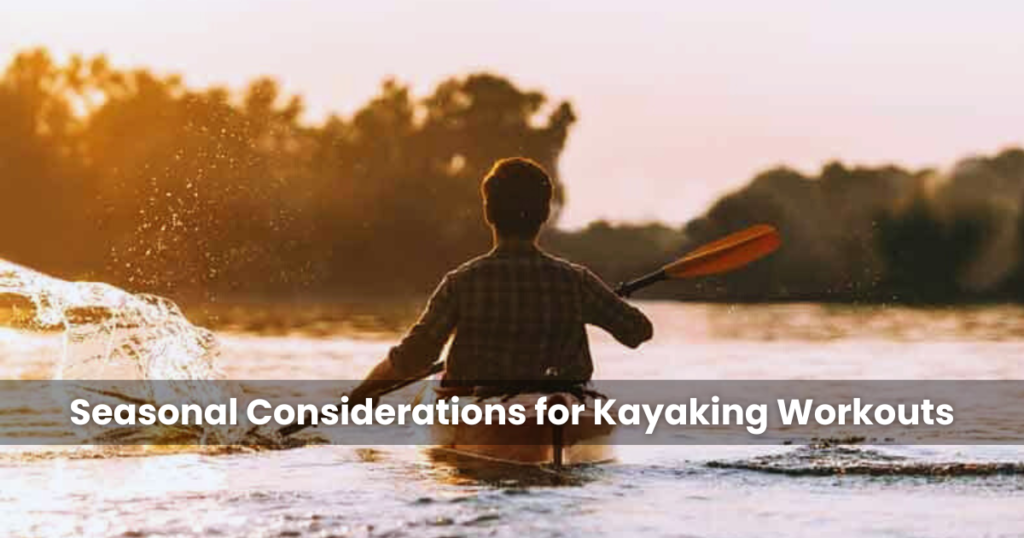
Kayaking is a versatile activity that can be enjoyed year-round, but the changing seasons bring unique challenges and opportunities for your calorie-burning efforts. Adapting your kayaking routine to match the seasons not only enhances your overall experience but can also significantly impact the number of calories you burn.
During the warmer months, kayaking often feels more effortless due to calm waters and pleasant temperatures. However, don’t be fooled by the ease you’re still burning a substantial number of calories. The heat actually increases your body’s energy expenditure, potentially boosting your calorie burn by 10-15%. To maximize your workout in summer, consider:
- Paddling during cooler morning or evening hours
- Increasing your duration or intensity to compensate for easier conditions
- Incorporating interval training by alternating between leisurely paddling and vigorous sprints
As autumn approaches, the changing scenery provides a perfect backdrop for longer kayaking sessions. The cooler temperatures allow for extended periods of exertion without overheating, potentially increasing your overall calorie burn.
Winter kayaking presents a unique set of challenges and rewards for the adventurous paddler. While it may seem counterintuitive, kayaking in colder conditions can significantly increase your calorie burn. The body works harder to maintain its core temperature, resulting in a higher energy expenditure. Some experts estimate that winter kayaking calorie burn can be up to 50% higher than in milder conditions.
However, winter kayaking requires special considerations:
- Invest in proper cold-weather gear to stay safe and comfortable
- Plan shorter trips to avoid prolonged exposure to harsh conditions
- Focus on maintaining a steady, moderate pace rather than intense bursts of activity
- Always inform someone of your plans and never kayak alone in winter
As spring returns, gradually increase your kayaking duration and intensity to build back any fitness lost during the winter months. This is an excellent time to set new goals and challenge yourself with varied paddling techniques.
Conclusion
In conclusion, How Many Calories Does Kayaking Burn is a question with a multifaceted answer. The calorie burn from kayaking varies widely based on factors such as intensity, duration, body weight, and environmental conditions. On average, a person can expect to burn between 300-500 calories per hour during moderate kayaking. However, this number can increase significantly with more vigorous paddling or challenging conditions. Understanding How Many Calories Does Kayaking Burn empowers enthusiasts to tailor their workouts for optimal fitness results, whether they’re seeking a leisurely paddle or an intense cardio session. Ultimately, kayaking offers a versatile, enjoyable way to burn calories while connecting with nature and improving overall health.
FAQs About Calories Does Kayaking Burn
Is kayaking a good workout for weight loss?
Absolutely! Kayaking is an excellent low-impact, full-body workout that can significantly contribute to weight loss. As you paddle, you engage your arms, shoulders, back, and core muscles, while also working your legs for stability. Depending on factors like intensity and duration, kayaking can burn anywhere from 300 to 500 calories per hour, making it an effective choice for those looking to shed pounds while enjoying the great outdoors.
How often should I kayak to see fitness results?
For noticeable fitness improvements, aim to kayak at least 2-3 times per week for 30-60 minutes per session. Consistency is key when it comes to any exercise routine. As you build strength and endurance, gradually increase your kayaking frequency and duration. Remember to listen to your body and allow for proper rest between sessions to avoid overexertion.
Can beginners burn as many calories as experienced kayakers?
While experienced kayakers may have an edge in terms of technique and efficiency, beginners can still burn a substantial number of calories. In fact, novice paddlers might even burn more calories initially as they expend extra energy learning proper form and navigation. As you become more proficient, you’ll likely be able to paddle for longer periods and at higher intensities, potentially increasing your overall calorie burn.
Does kayaking burn more calories than walking?
Generally speaking, kayaking burns more calories than walking at a moderate pace. While a 30-minute walk might burn around 150-200 calories, the same amount of time spent kayaking can torch 200-300 calories or more, depending on factors like water conditions and paddling intensity. However, both activities have their merits, and incorporating a mix of exercises into your fitness routine is ideal for overall health and weight management.
What’s the best kayaking technique for maximum calorie burn?
To maximize calorie burn while kayaking, focus on maintaining a steady, moderate to high-intensity paddling rhythm. Engage your core muscles and use a full range of motion in your arms and torso with each stroke. Interval training can also boost calorie expenditure try alternating between periods of vigorous paddling and more relaxed strokes. Additionally, challenging yourself with activities like kayak sprints or navigating through rougher waters can increase the workout’s intensity and calorie-burning potential.
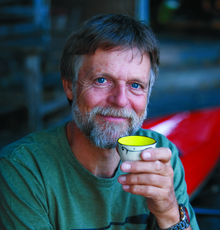
Nigel Foster, born in 1952, is an esteemed sea kayaker, known for being the youngest to kayak around Iceland. His journey in kayaking started at 15 in Brighton, England. With a career beginning as a trainee instructor in Sussex, he later pursued teaching after attending Redland College, Bristol.
Foster’s notable expeditions include navigating the challenging waters of Newfoundland and the Hudson Strait. Despite facing intense conditions, his passion for kayaking never waned. He holds several British Canoe Union qualifications and has significantly contributed to the kayaking community through teaching and committee work.
In 1985, Foster expanded his horizons by assisting an expedition in Iceland and later founded his own kayaking business, sharing his expertise globally.
